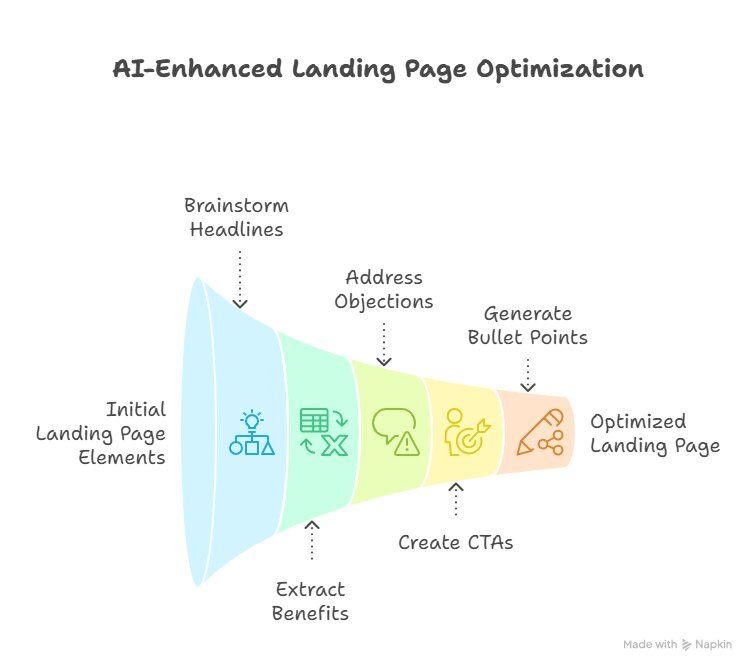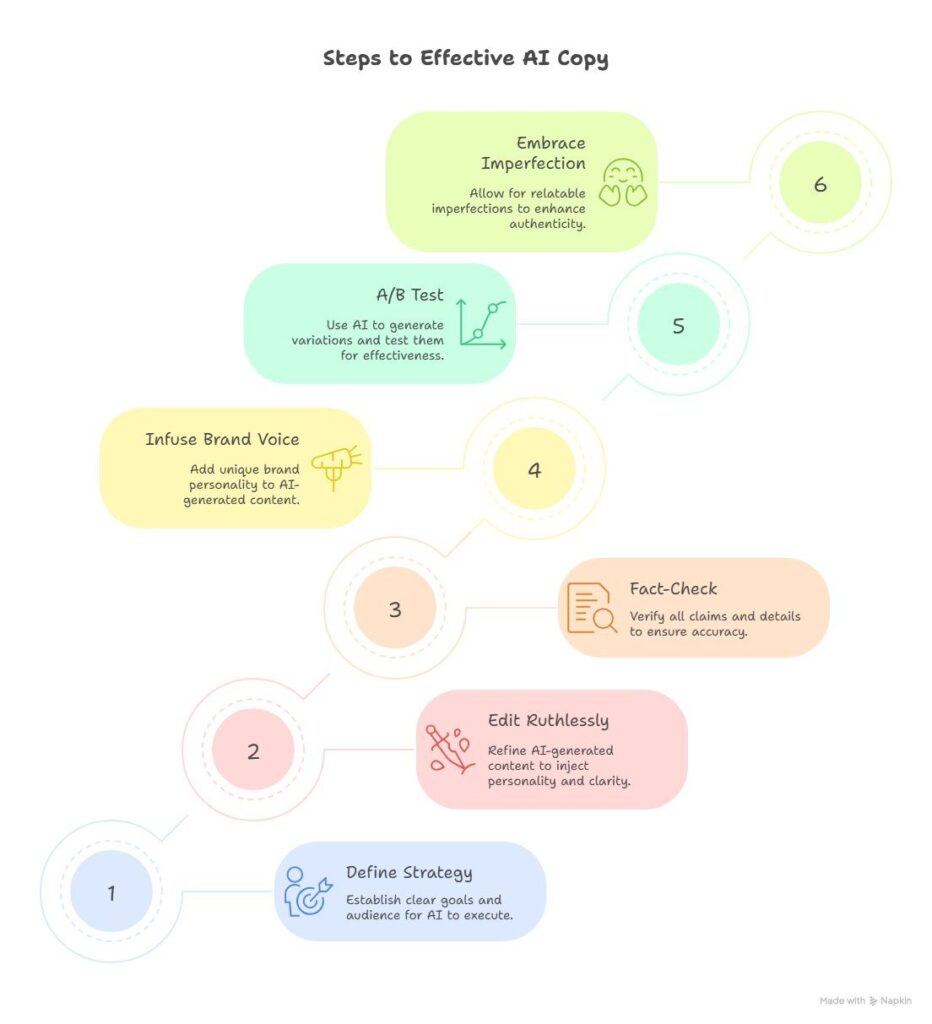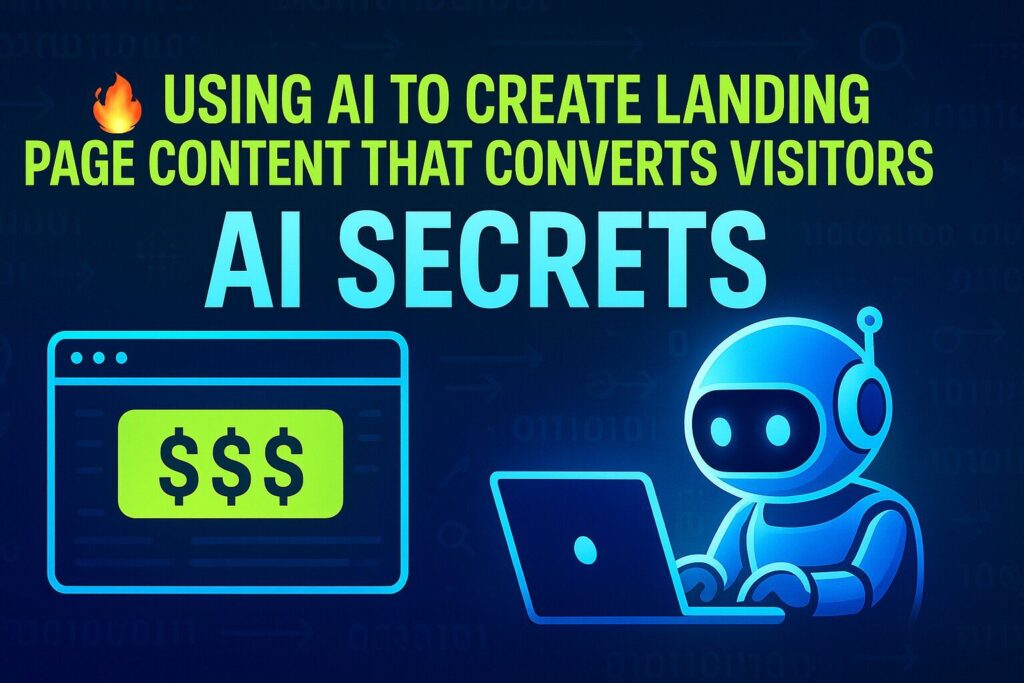Table of Contents
Introduction
Okay, let’s cut the fluff. You’re here because you know your landing page is supposed to be your digital sales superstar. But maybe… just maybe… it feels more like that slightly awkward person at a party trying way too hard to sell essential oils? Yeah, we’ve all been there. You pour your heart into crafting the perfect message, tweak the design endlessly, and then… crickets. Or worse, visitors bounce faster than a kangaroo on a trampoline. Frustrating, right?
Here’s the thing I learned the hard way (after burning through more coffee than I care to admit): Great landing page copy isn’t just about sounding clever; it’s about connecting the right problem with your specific solution in a way that feels effortless for the visitor. And guess what? AI has become my secret weapon for doing exactly that. No, it’s not magic (though sometimes it feels close!), and it won’t replace your brain, but holy smokes, it can turbocharge the process of creating copy that actually converts.
So, grab a coffee (or your beverage of choice), and let’s chat about how to use AI to stop the scroll and start the sign-ups, purchases, or whatever glorious action you want visitors to take. Forget the robotic jargon; we’re keeping this real.
Why Your Landing Page Copy is Probably Giving You Headaches (And How AI Can Help)
Let’s be honest for a sec. Writing landing page copy is often a special kind of torture. You stare at the blank screen. You write a headline. You delete it. You write another. You hate it. You channel your inner Shakespeare. It sounds ridiculous. You question your life choices. Sound familiar?
The core problems usually boil down to:
- The Blank Page Terror: Where do you even start? Especially when you’re too close to your own product/service.
- Knowing Your Audience (Like, Really Knowing Them): Are you sure you’re speaking their language, hitting their pain points, and offering the solution they crave?
- Endless Tweaking & Second-Guessing: Is this headline strong enough? Does this CTA suck? Should I use “Get Started” or “Unlock My Potential”? (Spoiler: AI can test both!)
- Time Sink Supreme: You could spend days obsessing over a few paragraphs. Days you don’t have.
This is where AI swoops in like a caffeine-fueled sidekick. Think of it less as a robot writer taking your job, and more like an incredibly fast, never-tired brainstorming partner and copy assistant. Its superpower? Processing massive amounts of language data to generate ideas, variations, and structures instantly. It takes the initial friction out, leaving you more energy for strategy and that crucial human polish.
Getting Started: How to Actually Use AI for Landing Pages (Without Creating Robo-Gibberish)

Okay, so you’re intrigued. Maybe you’ve dabbled with ChatGPT or Claude. But how do you actually use it effectively for something as critical as a landing page? You can’t just type “Write me a landing page for my SaaS, kthxbye.” You’ll get… something. Probably not great. Maybe vaguely embarrassing.
The secret sauce is in the prompt. This is your instruction manual to the AI. The clearer and more specific you are, the better the output. IMO, this is where 90% of people go wrong. They expect magic with zero effort. Newsflash: Garbage in, garbage out. Even with AI.
Here’s how I structure my prompts to get usable gold:
- Define the Goal: What exactly should this page achieve? (e.g., “Get visitors to sign up for a free trial of our project management tool,” NOT just “Tell them about our tool.”)
- Know Thy Ideal Customer Avatar (ICA): Who are you talking to? Be painfully specific.
- Job Title/Role?
- Biggest Frustrations/Pain Points? (What keeps them up at night?)
- Desires/Goals? (What are they really trying to achieve?)
- Common Objections? (What might stop them from clicking that button?)
- Outline the Core Offer & USP: What are you selling? What makes it undeniably better/different? What’s the key transformation you promise?
- Provide Context & Tone: What’s your brand voice? (Funny? Serious? Authoritative? Supportive?) Any specific keywords you must include? Any competitor landing pages you like/dislike?
- Ask for Specific Outputs: Don’t just ask for “a landing page.” Ask for:
- 5 compelling headline options
- A subheadline that expands on the headline
- 3 benefit-focused bullet points
- A short, persuasive paragraph about the core solution
- 3 variations of a strong Call to Action (CTA) button text
Example Prompt Snippet (The Good Stuff):
“Hey Claude, I need help brainstorming landing page copy for my new AI-powered social media scheduling tool, ‘SkedPal’. Goal: Get social media managers for small businesses (5-50 employees) to sign up for a 14-day free trial.
- ICA: Stressed social media manager (maybe wearing 5 hats!), drowning in manual posting, struggling to prove ROI, worried about inconsistent posting hurting engagement. They crave time savings, better results (engagement/leads), and looking professional without spending hours.
- Pain Points: Wasting hours scheduling manually, forgetting to post, inconsistent branding, hard to track what works, feeling overwhelmed.
- Core Offer: SkedPal uses AI to suggest optimal posting times for their specific audience, auto-generates captions (they can edit!), finds relevant hashtags, provides simple analytics, and offers a visual calendar. USP: Truly ‘set it and forget it’ reliability with AI optimization, specifically built for the chaos of small biz social.
- Tone: Helpful, empowering, slightly upbeat but professional (not overly salesy or childish). Avoid jargon.
- Output Needed: 5 headline options focusing on pain relief or time savings. 1 subheadline. 4 benefit-focused bullet points. 1 short paragraph explaining the ‘how’ simply. 3 CTA variations for the main button (e.g., ‘Start My Free Trial’, ‘Claim My 14-Day Trial’).”
See the difference? This gives the AI concrete material to work with. You’re not asking it to invent everything from scratch; you’re asking it to remix and refine your core value proposition for your specific audience. The results are infinitely better.
AI’s Killer Features for Landing Page Domination

So, what can this digital buddy actually do well? Let’s break down the superpowers I lean on constantly:
- Brainstorming Bonanza (Headlines, Angles, Hooks):
- The Problem: Staring blankly at the cursor, willing a brilliant headline to appear. It rarely does.
- The AI Fix: Instantly generates dozens of headline variations based on your prompt. You get angles you never considered – pain-focused, benefit-focused, curiosity-driven, specific, bold. Scan the list, pick 2-3 contenders, then hack them apart and rebuild them into something even better. I rarely use an AI headline verbatim, but it gets me 90% there in 10 seconds. Worth it? Absolutely.
- Benefit Extraction & Reframing:
- The Problem: We get stuck listing features (e.g., “AI-powered scheduling”). But visitors care about benefits (“Reclaim 10 hours a week”).
- The AI Fix: Feed it your feature list and ask: “Transform these features into compelling customer benefits for [Your ICA].” It excels at translating “what it is” into “why it matters to them.” Crucially, it forces you to think benefit-first.
- Overcoming Objections Smoothly:
- The Problem: You know people are thinking, “Is this secure?” or “Sounds complicated…” or “But what about [Competitor]?”, but addressing it directly can feel clunky.
- The AI Fix: Ask: “Generate concise, reassuring responses to these common objections for [Your Product].” It provides natural language rebuttals you can weave in subtly. Pro Tip: Use these in FAQs or within benefit bullets. Anticipating doubts builds trust.
- Crafting Persuasive CTAs (Beyond “Click Here”):
- The Problem: “Submit”? Yawn. “Learn More”? Meh. Your CTA needs urgency and clarity.
- The AI Fix: “Generate 10 action-oriented CTA button texts for [Specific Goal] that create a sense of value or urgency for [ICA].” You’ll get gems like “Get My Free Plan,” “Unlock Time Savings,” “Start My Risk-Free Trial.” Test these! A/B testing CTAs is easy and AI gives you great variations to start with.
- Generating Compelling Bullet Points (The Scannable Gold):
- The Problem: Walls of text = ignored. People scan. Your bullet points must pop.
- The AI Fix: Provide your key features/benefits and ask: “Transform these into 4-5 scannable, benefit-driven bullet points using strong verbs, keeping them under 10 words each.” It forces conciseness and impact. Bullet points are conversion workhorses – don’t waste them!
- Personalization at Scale (The Holy Grail, Almost):
- The Problem: Generic landing pages convert worse than pages speaking directly to a segment.
- The AI Fix: Feed it different ICA descriptions and ask for tailored headline/body copy variations. While full dynamic personalization needs more tech, AI lets you create multiple tailored versions incredibly fast for different ads or segments. Game changer for testing.
The Toolbox: My Go-To AI Wizards (And How I Use Them)
The AI landscape is wild, right? New tools pop up weekly. After testing a frankly ridiculous number, here’s where I consistently land:
- ChatGPT (OpenAI – GPT-4): My daily driver. Best for: Brainstorming, generating initial drafts, overcoming writer’s block, exploring angles, refining language. Why I Like It: Incredibly versatile, great for conversation (refining ideas iteratively), strong reasoning. Watch Out: Can get verbose or generic if your prompts are weak. Needs strong direction. Requires subscription (GPT-4 is worth it).
- Claude (Anthropic): A close second, sometimes edging out ChatGPT. Best for: Understanding complex prompts, generating concise and well-structured copy, handling longer documents. Why I Like It: Feels slightly more “natural” and less flowery sometimes. Excellent at summarization and extracting key points from your inputs. Watch Out: Slightly less creative in wild brainstorming than ChatGPT sometimes, but often more usable output faster.
- Gemini (Google): Solid contender, integrates well with Google Workspace. Best for: Quick research integration, decent drafting, accessibility (free tier is good). Why I Like It: Good for fact-checking aspects while writing. Integrates search sometimes (be careful!). Watch Out: Can be hit-or-miss on creativity and depth compared to ChatGPT/Claude. Sometimes overly cautious.
My Personal Workflow (FYI):
- Deep Dive on ICA/Pains/Offer: I do this myself first. No skipping!
- Craft a Mega-Prompt: Like the example above. I put serious time into this.
- Run it in ChatGPT or Claude: Generate the raw material.
- Copy/Paste into Google Docs: My playground.
- Hack, Slash, Rewrite, Reorganize: This is where I earn my keep. I treat AI output like clay, not scripture.
- Refine Tone & Voice: Inject my brand’s personality. AI often sounds neutral.
- Fact-Check Ruthlessly: AI hallucinates. Verify stats, claims, features.
- Run Specific Sections Back Through AI: E.g., “Make these 3 bullet points punchier and more benefit-focused.”
- Human Edit, Polish, Repeat.
The key? AI does the heavy lifting of ideation and drafting. I do the strategic thinking, the prompting, the brutal editing, and the final human touch. It’s a partnership.
Best Practices: Making Sure Your AI-Assisted Copy Doesn’t Suck

Using AI effectively isn’t just about the tools; it’s about the approach. Here’s how to avoid creating landing page Frankensteins:
- You Are the Strategist, AI is the Assistant: Never outsource your thinking. You define the audience, the offer, the goals, the USP. AI executes your vision. If you don’t have a clear strategy, AI output will be aimless.
- Edit Like a Demon (Because You Must): AI copy is a first draft, period. It will be generic, repetitive, or slightly off-tone. Your job is to ruthlessly edit, inject personality, tighten sentences, and ensure every word serves the conversion goal. Cut the fluff, sharpen the points. Ever read AI copy that just felt… hollow? That’s a lack of human editing.
- Fact-Check Everything: Seriously. AI models make stuff up (“hallucinations”). They might invent stats, misattribute benefits, or get technical details wrong. Verify every claim, feature description, and statistic before it goes live. Trust, but verify. Twice.
- Infuse Your Brand Voice: AI tends towards neutral. You must layer in your unique brand personality – the humor, the quirks, the specific way you talk to your customers. Is your brand a supportive coach? A witty expert? A no-nonsense problem solver? Make sure the final copy reflects that.
- A/B Test Religiously (AI’s Best Friend): One of AI’s biggest gifts? Generating variations effortlessly. Use it to create multiple headlines, CTAs, or even hero section variations, then A/B test them! Data beats opinion every time. Stop guessing what works; let your visitors tell you. Tools like Google Optimize, Optimizely, or even simpler plugin solutions make this accessible.
- Beware the “Too Perfect” Trap: Sometimes AI copy can feel a little too smooth, lacking the subtle imperfections that make human writing relatable. Don’t be afraid to break a grammar rule for emphasis or add a conversational aside if it fits your brand. Authenticity converts.
The Limitations: What AI Can’t Do (Yet)
Look, I’m an AI enthusiast, but I’m not delusional. Let’s talk about where it still falls short:
- Deep Customer Empathy & Nuance: AI analyzes patterns; it doesn’t feel frustration or joy. While it can mimic empathy based on data, the deepest understanding of your specific audience’s emotional journey still comes from you – talking to customers, reading reviews, feeling their pain. AI can’t replicate that lived experience.
- Truly Original Big Ideas or Brand Positioning: AI remixes existing information. It won’t spontaneously generate a revolutionary brand positioning or a completely novel market category. That requires human creativity, intuition, and strategic leaps. AI helps execute and refine the expression of big ideas, not invent them from scratch.
- Understanding Hyper-Specific Industry Jargon (Without Help): If your niche has super obscure acronyms or very specific technical terms, the base models might fumble. You need to educate the AI within your prompts by providing clear definitions and context. Don’t assume it knows your internal lingo.
- Replicating Unique Human Wit & Storytelling Flair: AI can be funny in a predictable, pattern-matching way. Truly unique humor, captivating personal anecdotes, or incredibly distinctive storytelling voices are still firmly in the human domain. Use AI to set the stage, but bring the special sauce yourself.
- Ethical Judgment & Brand Safety: AI generates based on its training data, which can contain biases or generate inappropriate content. You are always responsible for the final output. Review everything with a critical eye for bias, tone-deafness, or potential offensiveness. Does this really align with our values?
Wrapping It Up: Your AI-Powered Landing Page Journey
So, where does this leave us? Using AI for landing page content isn’t about finding a magic “write my profits” button. It’s about leveraging an incredibly powerful tool to overcome the friction of creation, generate better ideas faster, and free up your mental energy for the high-level strategy and human connection that truly drives conversions.
Remember these core takeaways:
- Prompt Like a Pro: Garbage in, garbage out. Specificity and context are king. Invest time here.
- AI = Draft Generator: Its output is raw material, not finished gold. Edit ruthlessly and inject your brand soul.
- Focus on Benefits & Objections: Use AI to relentlessly translate features into “what’s in it for them” and tackle doubts head-on.
- Variation is Your Friend: Generate multiple headlines, CTAs, angles. Then TEST them (A/B testing is non-negotiable!).
- You Are the Essential Ingredient: Strategy, empathy, brand voice, ethical oversight, and final judgment – that’s all you. AI is the copilot, not the captain.
Is AI going to replace killer copywriters? Nah. But is it going to make you a hell of a lot faster, more efficient, and probably more effective at crafting landing pages that convert? Abso-freaking-lutely.
Don’t be intimidated. Start small. Pick one landing page that’s underperforming. Define your ICA and goal clearly. Craft a solid prompt. Generate some headlines or bullet points. See what sparks. Hack it apart. Rebuild it. See if it moves the needle.
It’s not about perfection on the first try; it’s about iterating faster and smarter than ever before. So, what are you waiting for? Go give that awkward digital salesperson a serious AI-powered upgrade. Your conversion rate (and your sanity) will thank you. 😉 Ready to see what your landing page can really do?
FAQs
1. Why is landing page content so important for conversions?
Your landing page is your digital salesperson. Weak copy = lost leads. AI helps you craft landing page content that speaks directly to visitor pain points and drives action.
2. Can AI really write a high-converting landing page from scratch?
Yes, but with a caveat. AI generates a strong landing page draft, but you must refine it for your brand voice, audience, and goals. Think of AI as your brainstorming partner, not a replacement for human strategy.
3. What’s the biggest mistake people make with AI-generated landing pages?
Using raw AI output without editing. Generic landing page content won’t convert. Always tweak headlines, CTAs, and benefits to match your unique offer.
4. How do I make sure my AI landing page doesn’t sound robotic?
- Inject personality: Add humor, slang, or anecdotes.
- Edit ruthlessly: Cut jargon and fluff.
- Use AI for structure, but rewrite key sections (like CTAs) by hand.
5. Which AI tools are best for landing page copy?
Top picks for landing page content:
- ChatGPT (for brainstorming)
- Claude (for concise, benefit-focused bullets)
- Jasper (for templates if you’re new to AI).
6. Should I A/B test my AI-generated landing page?
Absolutely! Test AI-created variations of:
- Headlines
- CTA button text
- Hero section copy.
Data beats guesses every time.
7. How long should a high-converting landing page be?
Depends on your offer! AI can help you:
- Short landing pages (1 scroll): For simple offers (e.g., free trial).
- Long landing pages (10+ scrolls): For complex products needing social proof.
8. Can AI optimize my existing landing page for better conversions?
Yes! Feed AI your current landing page content and ask:
- “Improve clarity and benefits here.”
- “Suggest 3 stronger headlines.”
- “Shorten this section without losing impact.”
9. What’s the #1 AI prompt for landing page success?
Try this:
“Act as a conversion copywriter. Write a [landing page] for targeting [audience]. Focus on [key benefit]. Use [tone]. Include: 1 headline, 3 subheads, 4 bullet points, 1 CTA.”
10. How often should I update my landing page content?
Refresh it quarterly or after big product changes. Use AI to:
- Generate new angles.
- Update outdated stats.
- Repurpose top-performing sections.

